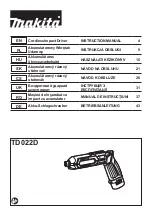
3
CAT4150
Rev. 06/04/10
Operating Instructions • Warning Information • Parts Breakdown
AIR SUPPLY
Tools of this class operate on a wide range of air pressures.
It is recommended that air pressure of these tools measures
90 PSI at the tool while running free. Higher pressure (over
90 psig; 6.2 bar) raises performance beyond the rated
capacity of the tool which will shorten tool life because of
faster wear and could cause injury.
Always use clean, dry air. Dust, corrosive fumes and/or
water in the air line will cause damage to the tool. Drain
the air tank daily. Clean the air inlet filter screen on at least
a weekly schedule. The recommended hookup procedure
can be viewed in the above figure.
The air inlet used for connecting air supply, has standard
1/4" NPT. Line pressure should be increased to compensate
for unusually long air hoses (over 25 feet). Minimum hose
diameter should be 3/8" I.D. and fittings should have the
same inside dimensions and be tightly secured.
LUBRICATION
Lubricate the tool daily with quality air tool oil. If no air
line oiler is used, run a half ounce of oil through the tool.
The oil can be squirted into the tool air inlet or into the
hose at the nearest con nec tion to the air supply, then run
the tool. Overfilling will cause a re duc tion in the power of
the tool. A rust inhibitive oil is acceptable for air tools.
WARRANTY
Cornwell warrants its air tools for a period of 1 year to the consumer. We will repair any CAT4150 covered under
this warranty which proves to be defective in material or workmanship during the warranty period. In order to
have your tool repaired, return the tool to any Cornwell Authorized Warranty Center, freight prepaid. Please in-
clude a copy of your proof of purchase and a brief description of the problem. The tool will be inspected and if any
part or parts are found to be defective in material or workmanship, they will be repaired free of charge and the
repaired tool will be returned to you freight prepaid.
This warranty gives you specific rights. You may also have other rights which vary from state to state.
The foregoing obligation is Cornwell’s sole liability under this or any implied warranty and under no circumstances
shall Cornwell be liable for any incidental or consequential damages.
Note: Some states do not allow the exclusion or limitation of incidental or consequential damages, so the above
limitation or exclusion may not apply to you.
OPERATION
The air regulator can be used to adjust torque to the
approximate tightness of a known fastener. To set the tool
to desired torque, select a nut or screw of known tightness
of the same size, thread pitch and thread condition as
those on the job. Turn air regulator to low position,
apply wrench to nut and gradually increase power (turn
regulator to admit more air) until nut moves slightly in
the direction it was originally set. The tool is now set to
duplicate that tightness - Note regulator setting for future
use. When tightening nuts not requiring critical torque
values, run nut up flush and then tighten an additional
one-quarter to one-half turn (slight additional turning is
necessary if gaskets are being clamped). For additional
power needed on disassembly work, turn regulator to its
fully open position. This impact wrench is rated at 1/2" SAE
bolt size. Rating must be down graded for spring U bolts,
tie bolts, long cap screws, double depth nuts, badly rusted
conditions and spring fasteners as they absorb much of the
impact power. When possible, clamp or wedge the bolt to
prevent springback.
Soak rusted nuts in penetrating oil and break rust seal
before removing with impact wrench. If nut does not start
to move in three to five seconds use a larger size impact
wrench. Do not use impact wrench beyond rated capacity
as this will drastically reduce tool life.
The reversing valve is used to change the rotation of the
tool. When the valve is out, the tool is in a forward or right
hand rotation. When the valve is pushed in, the rotation is
reverse or left hand.
NOTE:
Actual torque on a fastener is directly related to
joint hardness, tool speed, condition of socket and the time
the tool is allowed to impact.
Use the simplest possible tool-to-socket hook up. Every
connection absorbs energy and reduces power.






















